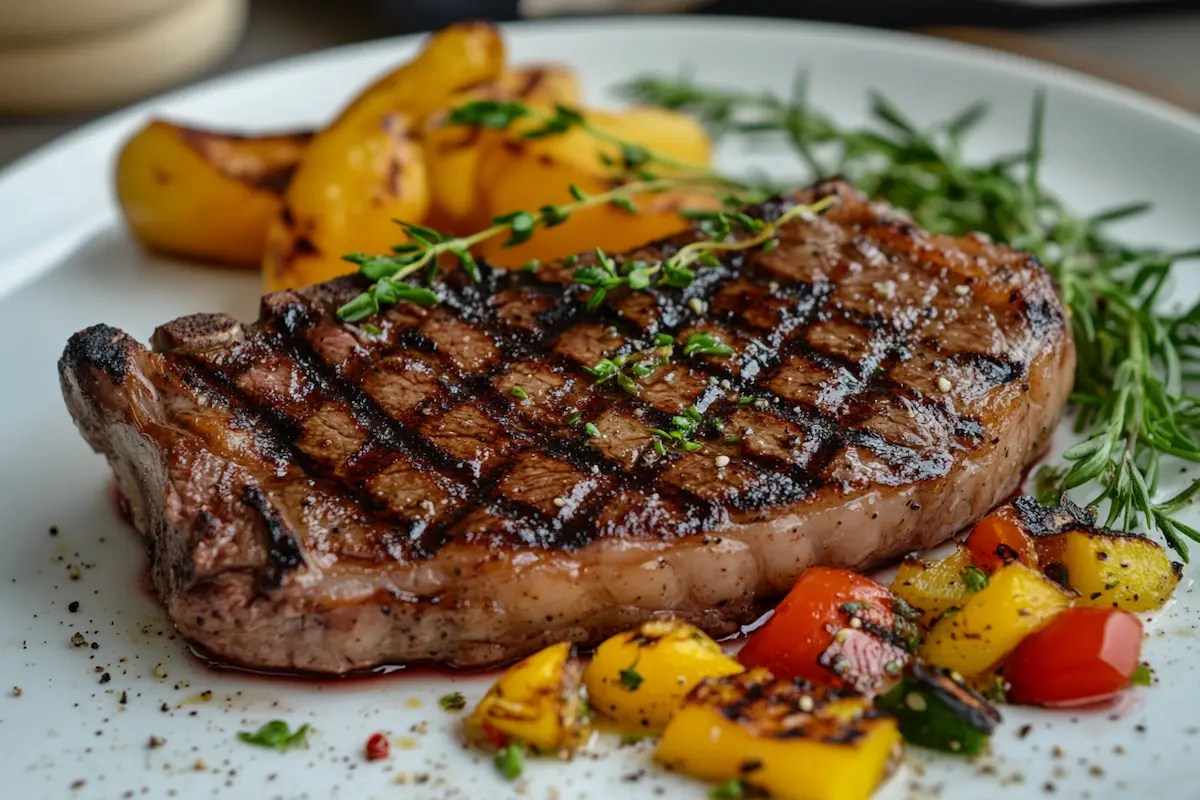1. Introduction to Ribeye Steak
1.1 What is Ribeye Steak?
Ribeye steak, also known as the “king of steaks,” is a premium cut that comes from the rib section of a cow. With its rich marbling and intense flavor, it’s prized for its juiciness and tenderness when grilled. The marbling melts during cooking, creating a mouthwatering experience.
1.2 Why Choose Ribeye Steak for Grilling?
Ribeye is tailor-made for grilling, thanks to its fat content and robust taste. The high fat ensures the steak stays moist, even over high heat. Whether you’re hosting a backyard barbecue or a quiet dinner, this cut guarantees a memorable meal.
1.3 Nutritional Value of Ribeye Steak
Ribeye isn’t just about taste—it’s also a nutritional powerhouse. Packed with protein, iron, and essential vitamins like B12, this cut offers a hearty, satisfying option. It’s also an excellent energy booster, perfect for active lifestyles.
2. Preparing for Grilling Ribeye Steak
2.1 Choosing the Perfect Ribeye Steak
Not all ribeye steaks are created equal. Selecting the right one is crucial for a mouthwatering result. Look for steaks with ample marbling, as the fat veins enhance flavor and tenderness.
2.1.1 Bone-In vs. Boneless Ribeye
Bone-in ribeye steaks, often called “cowboy steaks,” are known for their added flavor, thanks to the bone. Boneless ribeyes, on the other hand, are easier to handle and cook more evenly. Either way, make sure the steak is at least 1 to 1.5 inches thick for optimal grilling.
2.2 Should You Dry-Age Your Ribeye Steak?
Dry-aging takes the flavor to a whole new level. By storing the steak in a controlled environment for several weeks, moisture evaporates, and natural enzymes break down muscle tissue, intensifying the taste. While it might sound complicated, you can dry-age ribeye at home with some patience and care.
2.3 How to Properly Season a Ribeye Steak for Grilling
Seasoning is an art that starts with simplicity. Generously apply salt and freshly cracked black pepper, ensuring even coverage. If you’re feeling adventurous, add garlic powder, paprika, or a steak-specific spice blend. Remember, seasoning should enhance, not overpower, the steak’s natural flavor.
2.4 Why Resting the Steak Before Grilling is Crucial
Rushing the grilling process can lead to uneven cooking. Let your ribeye rest at room temperature for about 30 minutes before placing it on the grill. This step ensures consistent cooking from edge to center, giving you that perfect medium-rare finish.
3. The Best Techniques for Grilling Ribeye Steak
3.1 What Type of Grill is Best for Ribeye Steak?
The choice of grill can make or break your ribeye steak experience. Here’s a quick comparison:
- Charcoal Grills: These provide that classic smoky flavor many steak lovers adore. They’re perfect for a deep, charred crust.
- Gas Grills: Convenient and easy to control, gas grills are great for achieving consistent heat.
- Pellet Grills: Ideal for low-and-slow cooking with a hint of smoky flavor.
Each option has its strengths, but charcoal is often the go-to for flavor purists.
3.2 Direct vs. Indirect Grilling: Which is Better?
Both methods have their place when grilling ribeye steak.
- Direct Grilling: Best for achieving a quick, seared crust. Place the steak directly over the hottest part of the grill.
- Indirect Grilling: Ideal for thicker cuts. Start the steak on the cooler side of the grill to cook through, then finish with a sear.
Using a combination of both methods often yields the best results.
3.3 The Perfect Grill Temperature for Ribeye Steak
Temperature control is the key to steak perfection. Preheat your grill to about 450°F (232°C) for searing. For indirect grilling, maintain a lower zone at 250–300°F (121–149°C). Use a meat thermometer to check internal temperatures:
- Medium-rare: 130–135°F (54–57°C)
- Medium: 135–145°F (57–63°C)
- Well-done: 155°F+ (68°C+)
3.4 Step-by-Step Guide
- Preheat your grill to the right temperature.
- Brush the grates with oil to prevent sticking.
- Place the ribeye on the grill over direct heat for 3–4 minutes per side to create sear marks.
- Move to indirect heat and cook until desired doneness.
- Let the steak rest for 5–10 minutes before serving to lock in juices.
3.5 How Long to Grill Ribeye Steak for Perfect Results
Cooking times depend on the steak’s thickness and your preferred doneness:
- 1-inch steak, medium-rare: 6–8 minutes total
- 1.5-inch steak, medium-rare: 10–12 minutes total
Adjust accordingly and always rely on a thermometer for accuracy.
4. Enhancing the Flavor of Ribeye Steak
4.1 Adding Smoky Flavor to Your Ribeye Steak
A smoky aroma takes grilled ribeye steak to another level. Use wood chips such as hickory, oak, or mesquite to infuse that irresistible flavor. Soak the wood chips in water for about 30 minutes, then place them in a smoker box or directly on the charcoal. The smoke will seep into the meat, enhancing its rich taste.
4.2 Best Marinades
While ribeye shines on its own, a well-crafted marinade can amplify its flavor:
- Simple Garlic Herb Marinade: Combine olive oil, minced garlic, rosemary, thyme, and a splash of lemon juice.
- Bold and Spicy Marinade: Use soy sauce, Worcestershire sauce, garlic powder, paprika, and a touch of chili flakes.
Marinate the steak for at least 2 hours or overnight for maximum flavor penetration.
4.3 Should You Use Butter While Grilling Ribeye Steak?
Absolutely! Adding butter enhances the steak’s flavor and creates a luscious finish. A dollop of garlic herb butter during the last minute of grilling melts over the steak, adding richness and aroma. For a twist, try compound butter infused with ingredients like blue cheese or smoked paprika.
4.4 Pairing Ribeye Steak with Herbs and Spices
Herbs and spices elevate the natural flavors of ribeye steak. Consider combinations like:
- Rosemary and thyme for an earthy tone.
- Smoked paprika and garlic powder for a bold kick.
- Fresh parsley or cilantro as a finishing touch for added brightness.
A spice rub with kosher salt, black pepper, and cayenne can create a mouthwatering crust.
5. Common Grilling Mistakes and How to Avoid Them
5.1 Overcooking or Undercooking Ribeye Steak
One of the most common pitfalls is not cooking the steak to the desired doneness. To avoid this:
- Use a reliable meat thermometer to monitor the internal temperature.
- Remember that steak continues to cook as it rests, so remove it from the grill 5°F below your target temperature.
5.2 Not Letting the Steak Rest After Grilling
Skipping the resting stage leads to juices escaping as soon as you cut into the steak. Always let the ribeye rest for 5–10 minutes after grilling. Cover it loosely with foil to keep it warm while the juices redistribute.
5.3 Flare-Ups and Uneven Cooking
Grease drippings can cause flare-ups, leading to uneven cooking or burnt spots. Here’s how to avoid them:
- Trim excess fat from the edges of the steak.
- Keep a spray bottle of water handy to control small flare-ups.
- Use the indirect grilling method for better heat control.
5.4 Seasoning Mistakes
Under-seasoning or overloading with spices can ruin the steak’s natural flavor. Follow these tips:
- Season generously but evenly, ensuring every bite has a balanced taste.
- Avoid adding sugary marinades directly on the grill to prevent charring.
6. Serving Grilled Ribeye Steak Like a Pro
6.1 How to Slice Ribeye Steak for Maximum Flavor
The way you slice your ribeye can make all the difference. Always slice against the grain to break down the muscle fibers and create a tender bite. Use a sharp knife and cut into thin, even slices. This technique ensures every piece is juicy and flavorful.
6.2 Side Dishes That Pair Perfectly with Ribeye Steak
A well-chosen side dish complements the richness of ribeye steak. Here are some tried-and-true options:
- Mashed Potatoes: Creamy and buttery, they balance the steak’s bold flavor.
- Grilled Vegetables: Asparagus, bell peppers, or zucchini bring freshness and texture to the plate.
- Classic Caesar Salad: A crisp salad with a tangy dressing provides a refreshing contrast.
6.2.1 Easy Sauce Ideas for Ribeye Steak
Enhance your steak with a drizzle of sauce:
- Chimichurri: A vibrant mix of parsley, garlic, olive oil, and red wine vinegar.
- Peppercorn Sauce: Creamy and slightly spicy, it pairs beautifully with ribeye’s boldness.
6.3 Presenting Your Grilled Ribeye Steak
Presentation matters, especially for a standout steak. Plate the ribeye on a clean white dish for contrast, garnish with fresh herbs like rosemary, and serve with your selected sides neatly arranged. A final sprinkle of coarse salt or cracked pepper can give the steak a gourmet finish.
7. Frequently Asked Questions (FAQs)
7.1 What is the Best Thickness for Grilling Ribeye Steak?
The ideal thickness for grilling ribeye steak is between 1 and 1.5 inches. This allows for a perfect sear on the outside while keeping the inside juicy and tender.
7.2 How Do You Know When Ribeye Steak is Done?
Using a meat thermometer is the most reliable way to determine doneness:
- Medium-rare: 130–135°F (54–57°C)
- Medium: 135–145°F (57–63°C)
- Well-done: 155°F+ (68°C+)
Alternatively, use the finger test for a quick estimate of doneness.
7.3 Can You Grill Ribeye Steak Without a Meat Thermometer?
Yes, you can, but it requires practice. Use the finger test: compare the firmness of the steak to the fleshy part of your palm beneath your thumb. It’s not as accurate as a thermometer, but it works in a pinch.
7.4 What’s the Difference Between Ribeye and Other Steak Cuts?
Ribeye is known for its rich marbling and intense flavor, making it juicier and more tender than cuts like sirloin or strip steak. Unlike filet mignon, which is lean and buttery, ribeye has a robust, beefy taste.
7.5 Do You Need to Marinate Ribeye Steak Before Grilling?
Not necessarily. Ribeye steak is flavorful enough on its own due to its marbling. However, a marinade can add a unique twist and enhance tenderness if desired.
7.6 How Long Should You Let Ribeye Steak Rest After Grilling?
Allow the steak to rest for 5–10 minutes after grilling. This step ensures that the juices redistribute, preventing them from spilling out when you cut into the steak.
8. How to Reheat it Without Losing Flavor
8.1 Why Proper Reheating Matters
Reheating ribeye steak incorrectly can lead to a dry, chewy texture, stripping it of its original juiciness. Proper reheating preserves the flavor, texture, and tenderness of the steak.
8.2 Best Methods
8.2.1 Reheating on the Stove
- Place a skillet over medium heat and add a small amount of butter or oil.
- Sear the steak for 1–2 minutes on each side to warm it through.
- Add a splash of beef broth or water and cover the skillet for 1–2 minutes to steam the steak gently.
8.2.2 Reheating in the Oven
- Preheat your oven to 250°F (120°C).
- Wrap the steak in aluminum foil with a tablespoon of beef broth to keep it moist.
- Heat the steak for about 20–30 minutes, depending on its thickness.
8.2.3 Using the Sous Vide Method
For a precise and foolproof approach, place the steak in a vacuum-sealed bag and heat it in a water bath at 130°F (54°C) for about 30 minutes. This method ensures even reheating without overcooking.
8.3 Tips for Reheating Without Overcooking
- Always bring the steak to room temperature before reheating.
- Avoid using a microwave, as it dries out the meat and creates uneven heating.
- Slice the steak thinly before reheating for quicker and more consistent results.
Looking for more comforting Southern dishes? Check out our guide to breaded cauliflower recipes for even more delicious inspiration!

